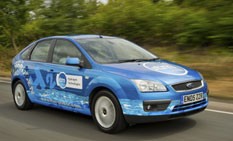Review
The future is now – and you can find it under the bonnet of this Ford Focus.
With its engine converted to run on hydrogen, this popular family hatchback provides a glimpse of how easy it could be for fleet and family drivers alike to make the switch to super-clean motoring.
After eight years of painstaking research, laboratory testing and a lot of hard work, ITM Power has perfected the technology to put a hydrogen refuelling station into any home or business.
For an investment said to be ‘a few thousand pounds’ when the technology gets into mass production, ITM’s basic electrolyser unit will turn water and an overnight charge of cheap-rate electricity into the equivalent of a gallon of petrol.
That’s sufficient to power the blue metallic Ghia model that Fleet News has been first to test.
As we’ve already reported, the development is seen as the breakthrough that finally opens the door to emission-free mobility that also reduces our dependence on ever more costly fossil fuels.
So where’s the catch?
The first can be found in the boot, where a huge tank fills the luggage space – but this is only a demonstration car and engineers point out that a car manufacturer could easily design another tank to fit beneath the floor.
The second concerns range, which rules out anything more than a local commute, although an advantage of the conversion is that the engine can be switched to and from petrol power.
The range can be stretched to 100 miles if the gas is compressed, but for the moment, compressed gas is available only at commercial refuelling stations – and hardly any exist here yet.
Out on the road, the Focus is as smooth and fuss-free as the standard car and remains quiet and refined at all speeds.
However, operating the car on hydrogen fuel brings an immediate 30 per cent drop in output to leave performance of the test model’s two-litre Duratec motor much on a par with the 1.6-litre version.
As a result, it’s less sprightly away from the lights but still capable of brisk travel.
Converting a car to use the ITM system is expected to cost less than £1,000 and involves fitting a gas tank, fuel lines, a regulator, injectors and a solenoid to shut down supply in the event of an accident.
Behind the wheel
Press the extra button on the dashboard of this unique Focus and there’s a slight nudge as hydrogen takes over from petrol.
And that’s it – no change in engine noise, no drama and nothing to set this Ford apart from any other.
Except for the performance.
Hydrogen adds another three seconds to the standard acceleration to 62mph, so it’s tempting to leave the engine running on petrol until the car has reached cruising rate.
And because the conversion operates at its best under wider throttle openings, the throttle needs to be blipped in stop-start conditions to spare the embarrassment of cutting out.
Verdict
With the average commute of 12 miles, the ITM system seems viable, but car manufacturers already offer a wide range of eco and alternative fuel models.
















